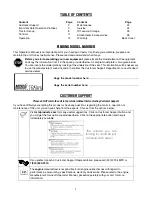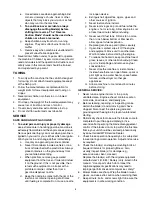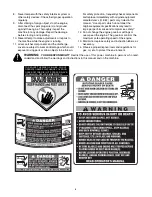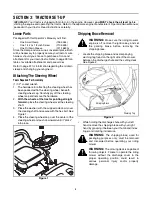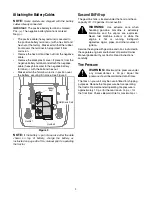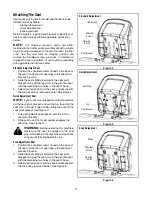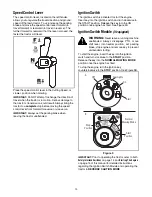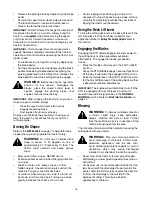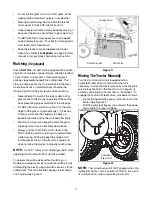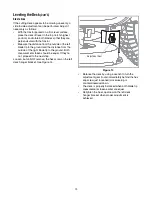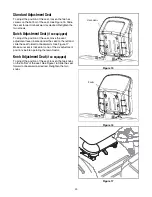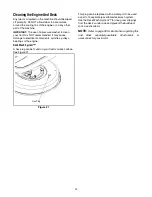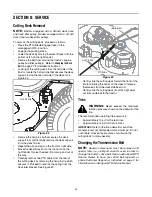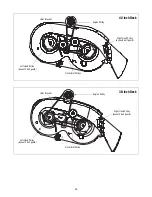
16
•
Release the parking brake by depressing the brake
pedal.
•
Position the speed control lever in desired position.
The further forward or rearward that the lever is
moved, the faster the tractor will travel. .
IMPORTANT:
Do NOT attempt to change the direction of
travel when the tractor is in motion. Always bring the
tractor to a
complete
stop before moving the speed
control lever from forward to reverse or vice versa.
Failure to do so could result in serious damage to your
tractor’s transmission.
IMPORTANT:
First-time operators should use slower
speeds. Become completely familiar with the tractor’s
operation and controls before operating the tractor in at
higher speed.
•
The lawn tractor is brought to a stop by depressing
the brake pedal.
•
Set the parking brake by fully depressing the brake
pedal and keeping it depressed while placing the
parking brake lever in the ON position. Release the
brake pedal to allow the parking brake to engage.
WARNING:
Before leaving the operator’s
position for any reason, disengage the
blades, place the speed control lever in
neutral, engage the parking brake, shut
engine off and remove the key.
IMPORTANT:
When stopping the tractor for any reason
while on a grass surface, always
•
Place the speed control lever in
N
(neutral),
•
Engage the parking brake,
•
Shut engine off and remove the key.
Doing so will minimize the possibility of having your
lawn ‘‘browned’’ by hot exhaust from your tractor’s
running engine.
Driving On Slopes
Refer to the
SLOPE GAUGE
on page 7 to help determine
slopes where you may operate the tractor safely.
WARNING:
Do not mow on inclines with a
slope in excess of 15 degrees (a rise of
approximately 2-1/2 feet every 10 feet). The
tractor could overturn and cause serious
injury.
•
Mow up and down slopes, NEVER across.
•
Exercise extreme caution when changing direction
on slopes.
•
Watch for holes, ruts, bumps, rocks, or other
hidden objects. Uneven terrain could overturn the
machine. Tall grass can hide obstacles.
•
Avoid turns when driving on a slope. If a turn must
be made, turn down the slope. Turning up a slope
greatly increases the chance of a roll over.
•
Avoid stopping when driving up a slope. If it is
necessary to stop while driving up a slope, start up
smoothly and carefully to reduce the possibility of
flipping the tractor over backward.
Using the Deck Lift Lever
To raise the cutting deck, move the deck lift lever to the
left, then place it in the notch best suited for your
application. Refer to
Setting The Cutting Height
earlier in
this section.
Engaging the Blades
Engaging the PTO (Blade Engage) transfers power to
the cutting deck or other (separately available)
attachments. To engage the blades, proceed as
follows:
•
Move the throttle control lever to the FAST (rabbit)
position.
•
Grasp the PTO (Blade Engage) lever and position it
all the way forward into the engaged (ON) position.
•
Keep the throttle lever in the FAST (rabbit) position
for the most efficient use of the cutting deck or other
(separately available) attachments
IMPORTANT:
The engine will automatically shut off if the
PTO is engaged with the shift lever in position for
reverse travel with the ignition key in the
NORMAL
MOWING
position. Refer to
Safety Interlock Switches
on
page 14.
Mowing
WARNING:
To help avoid blade contact or
a thrown object injury, keep bystanders,
helpers, children and pets at least 75 feet
from the machine while it is in operation. Stop
machine if anyone enters the area.
The following information will be helpful when using the
cutting deck with your tractor.
WARNING:
Plan your mowing pattern to
avoid discharge of materials toward roads,
sidewalks, bystanders and the like. Also,
avoid discharging material against a wall or
obstruction which may cause discharged
material to ricochet back toward the operator.
•
Never mow at the tractor’s fastest ground speed.
Maintaining a slower ground speed will result in an
optimal cut.
•
For best results it is recommended that the first two
laps be cut with the discharge thrown towards the
center. After the first two laps, reverse the direction
to throw the discharge to the outside for the
balance of cutting. This will give a better
appearance to the lawn.
Summary of Contents for 791
Page 29: ...29 NOTES ...
Page 30: ...30 NOTES ...

